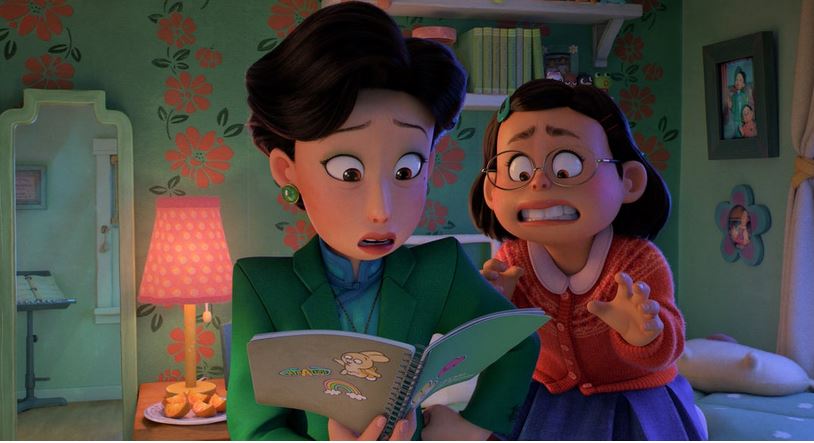By Erin Chew, AsAmNews Staff Writer
There is a scene in Turning Red where the protagonist – 13-year-old Toronto teenager Mei ( voiced by Rosalie Chiang) is drawing a picture of her crush Devon. She puts in all her teenage feelings for him in the sketch as her mother Ming ( voiced by Sandra Oh) walks into her bedroom unannounced. Mei quickly kicks the book under the bed, but it’s too late as her mother sees it and Mei’s boy craziness is all exposed.
That particular scene is one of many reminiscent of being Asian, teenager and that awkward relationship Asian teenagers growing up in the West generally have with their parents which is part and parcel of migrant and generational issues, and it is why this Pixar animated film is so relevant to both Asians and anyone who has grown up in a migrant family everywhere.
What is even more interesting is that this animation is inspired by the childhood of the animation’s director Domee Shi. For Shi, a teenager growing up in Toronto in the 2000s, Turning Red is more than just creative work.
“I was really excited and passionate about directing a coming of age girl’s story and exploring the topic of puberty and change and using all this as a creative metaphor,” she tells AsAmNews. “It might sound weird, but working on this project was fun because it is basically my own life growing up in the earlier part of this century in Toronto Canada, and going through the changes and puberty blues of Asian Canadian teenagers.”
Production designer Rona Liu who aided Shi in making Turning Red, also previously worked with her on the Oscar-winning short film Bao. She shared the sentiments mentioned by Shi, and added that this was what made working on Turning Red a unique experience.
“In my career, working on Turning Red was an experience in itself as it was a therapeutic journey and a personal one for both Domee and me,” Liu said. “To add on we all had complex relationships with our parents, I know both Domee and myself did and so does Mei with her mom.”
To make an animation like Turning Red, requires a lot of nuanced characters, and it is important that this is all done correctly from the start. Because it involves characters who come from not only an Asian background, but from many other people of colored backgrounds, there needs to be care and sensitivity taken in ensuring the characters are adequately represented and at the same time tell the personal stories of being an Asian teenager growing up in Canada.
Shi spoke about a true balancing act to achieve this and at the same time to break away from any generalized and negative Asian stereotypes.

“To do this, I decided with the team to explore the complexities of the parent-child relationship between Mei and her mom and reflect what was real to us because that would be what many immigrant and Asian kids go through growing up. I wanted to show a mother’s love and how that changes for Mei as she starts to change in body and mind, which is represented by her turning into the red panda,” said Shi.
For Liu, to keep with Shi’s vision of being nuanced, personal, and meaningful, she really had to put out all stops as the production designer. Liu wanted to ensure the film would pay homage and honor to Asian parents and to all Asian kids who struggle to find where they belong. In many ways, Liu says that is the symbolic meaning behind Mei turning into a red panda and it was her job to work closely with Shi to achieve this.
“When we started, Domee and I would sit down together and really look through references and talk about our influences and our childhoods growing up Asian. I would do up a few paintings and we would create a guide to envision what the film was going to look like in terms of its chunky cuteness, vibrancy, what a teenage body would look like, said Liu.
“For everything about this film, it was the specificities of the landscape and environment, the characters facial expressions and the mixture of colors and shades etc we had to pay close attention to. And that is what makes this film powerful, I feel.”
Shi took lessons from her debut film with Pixar, Bao. Bao ended when the mom eats the baby dumpling. Shi questioned whether that scene would be misunderstood and shocking to her audiences. Her mentors encouraged her to stay true to her vision and that’s what she tried to do with Turning Red.
“The truth and staying true to who I am is what I took into creating Turning Red, and it is also why the film goes into many different and deep topics. It may get a little bit messy as you watch it, but it is real and I think that is what makes it a very impactful story.”
Turning Red will be released on Disney Plus on March 11.
AsAmNews has Asian America in its heart. We’re an all-volunteer effort of dedicated staff and interns. Check out our new Instagram account. Go to our Twitter feed and Facebook page for more content. Please consider interning, joining our staff, or submitting a story, or making a contribution.




